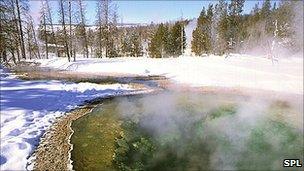Yellowstone supervolcano fed by bigger plume
- Published

Yellowstone's geysers are driven by a hot plume beneath the surface
The underground volcanic plume at Yellowstone in the US may be bigger than previously thought, according to a study by geologists.
The volcanic hotspot below Yellowstone feeds the hot springs, mud pots and geysers that bring millions of visitors to the US national park each year.
But the Yellowstone "supervolcano" has erupted violently in the distant past and could do so again at some point.
The study is set to be .
In 2009, researchers used seismic waves from earthquakes to build up an image of the hotspot beneath Yellowstone, which straddles the US states of Wyoming, Montana and Idaho.
The authors of the latest work used variations in the electrical conductivity of rocks to produce a new picture of the plume.
This conductivity is a property of the molten silicate rocks and the hot briny water that is naturally present in them.
"It's like comparing ultrasound and MRI in the human body; they are different imaging technologies," says co-author Michael Zhdanov, a professor of geophysics at the University of Utah in Salt Lake City.
Hot envelope
The 2009 images, using seismic waves, showed the plume of hot and molten rock dipping downward from Yellowstone at an angle of 60 degrees. This plume extended 240km (150 miles) west-northwest to a point at least 660km (410 miles) under the Montana-Idaho border.
This was as far as the seismic imaging could "see".
The new study, using electrical conductivity, can only see about 320km (200 miles) below ground.
Variations in electrical conductivity reveal the volcanic plume of partly molten rock
But it shows the conductive part of the plume dipping more gently, at an angle of perhaps 40 degrees to the west, and extending perhaps 640 km (400 miles) from east to west.
They may look different because the two techniques image slightly different things.
Seismic images highlight materials such as molten or partly-molten rock that slow seismic waves, while the geoelectric technique displays briny fluids that conduct electricity.
Co-author Robert B Smith, who is also at University of Utah, said the plume was bigger in the geoelectric picture. He said it could be inferred that there were more fluids than shown by the seismic images.
Despite differences, he says, "this body that conducts electricity is in about the same location with similar geometry as the seismically imaged Yellowstone plume."
The more gentle tilt of the geoelectric plume could suggest that the hot region imaged by the seismic wave technique may be enveloped by a broader, underground envelope of partly-molten rock and liquids, the researchers say.
There have been three huge eruptions of the Yellowstone supervolcano: 2.1 million years ago, 1.3 million years ago and 640,000 years ago. Two of these eruptions blanketed a large area of North America with volcanic ash.
The most recent full-scale eruption of the Yellowstone supervolcano ejected some 1,000 cubic km (240 cubic miles) of hot ash and rock into the atmosphere. There have been smaller eruptions in between the largest outpourings; the most recent of these occurred 70,000 years ago.
- Published3 September 2010